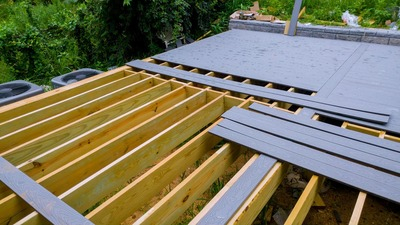If you are considering building decking in your garden, you may have a number of questions regarding the different types of materials, the maintenance they require and how they will wear over time.
For all your decking needs, here are some frequently asked questions with answers:
What is the best type of decking for gardens?
There are 2 different types of decking: composite and wooden. Composite is made of 95% recycled plastic but is of very high quality. Compared to wooden, which are natural wooden decking boards.
Both have pros and cons but to decide which is best for your garden make sure to read on:
Composite Decking
Positives
One of the biggest positives about composite decking is its cheap maintenance costs and longer life spans. Composite decking has a lifespan of around 20 years which is 10 more than traditional wooden decking. It is likely due to recent developments that composite decking's lifespan will only increase which is a big reason for its popularity.
Composite decking is known for its ability to handle a lot of pressure and weight which is why it's used around hot tubs. The main reason for its sturdiness is the materials it is built out of. The mix between wood and recycled plastic not only makes it strong but also realistic which is a major positive for composite decking.
Throughout the year your decking will experience freezing temperatures to the scorching sun which you would expect to cause many problems. However composite decking is the least likely type to have mould or algae growth on it. Composite decking comes in 3 different colours black grey and chocolate which makes it very aesthetically pleasing to have in your garden.
Negatives
Although composite decking is very aesthetically pleasing it comes at a cost, coming in at around double the price of natural wood decking boards which makes it one of the most expensive options for decking.
If you opt for composite decking in your garden it is important to take note of your surroundings before deciding the colour. Darker Composite is a very good absorber of heat meaning your decking can become untouchable on hot summer days. This also means that over time your decking would likely fade.
Another negative to having composite decking installed is the amount of infrastructure needed to install and hold up the decking. Composite decking is very heavy so therefore needs a lot of support and extra bits added on underneath and to the end in order to be structurally stable.
Wooden decking
Positives
Wooden decking boards come in a range of different types of wood and in the short term timber can be the most budget-friendly option. Pressure-treated wood has the lowest cost of any decking type coming in much cheaper than composite decking.
Timber offers a more natural look, something that you would get with composite decking. Sometimes you need the rustic charm timber can offer. Timber has a natural warmth that perhaps can’t be achieved by plastic or metal decking options. Timber can also be stained in various colours and finished with a number of textures.
Redwood and cedar labour costs tend to be much lower as they are much easier to install. This is mainly due to the ease of work as it can be cut, shaped and sanded quite simply.

Negatives
However, with wooden decking, there is a clear reason why it is cheaper to buy compared to composite or metal decking. The Cheaper timber options have the lowest life expectancy of any type of decking of around 10-15 years this is usually due to the likeliness of cracking and splintering.
Timber decking is high maintenance as it requires painting and staining annually to stop fading and erosion which adds to the maintenance cost of the decking. Upkeep can be expensive and time-consuming and boards may need to be replaced if the weather is damaged especially after large amounts of mould or algae have grown on them which causes them to decay over time.
The more durable hardwood timber can be expensive both in materials and labour. The need for made-to-measure designs ups labour and design costs considerably Though timber is considered a renewable material, it still involves cutting down trees. This means it isn't very environmentally friendly compared to composite decking which is made of recycled plastic.
What are the best accessories for your decking?
There are 2 important accessories to have with your decking are railings and lights. Both have a massive impact on the feel of your decking allowing you to change the feel too different parts of the decking
Railings
Deck railings have a big impact on the look of your outdoor space. Deck railings will help increase the safety of your decking and also give your decking a bit of structure. When building your decking consider mixing both wooden framing and metal poles to help give your decking that contemporary feeling.
Lights
Install lighting on your deck railings, or use solar spotlights to illuminate the garden around the patio Both will create a cosy ambience on your deck or patio. Thanks to a huge selection of outdoor solar lighting options, devising a lighting scheme is now easier than ever before. Add lights on your stairs or on the railings it's completely up to you.













